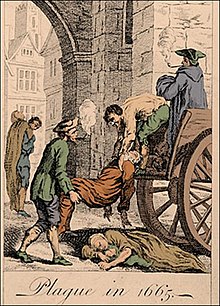Recurrences

Second plague pandemic
The plague repeatedly returned to haunt Europe and the Mediterranean throughout the 14th to 17th centuries. According to Biraben, the plague was present somewhere in Europe in every year between 1346 and 1671. (Note that some researchers have cautions about the uncritical use of Biraben's data.) The second pandemic was particularly widespread in the following years: 1360–63; 1374; 1400; 1438–39; 1456–57; 1464–66; 1481–85; 1500–03; 1518–31; 1544–48; 1563–66; 1573–88; 1596–99; 1602–11; 1623–40; 1644–54; and 1664–67. Subsequent outbreaks, though severe, marked the retreat from most of Europe (18th century) and northern Africa (19th century). The historian George Sussman argued that the plague had not occurred in East Africa until the 1900s. However, other sources suggest that the Second pandemic did indeed reach Sub-Saharan Africa.
According to historian Geoffrey Parker, "France alone lost almost a million people to the plague in the epidemic of 1628–31." In the first half of the 17th century, a plague claimed some 1.7 million victims in Italy. More than 1.25 million deaths resulted from the extreme incidence of plague in 17th-century Spain.
The Black Death ravaged much of the Islamic world. Plague was present in at least one location in the Islamic world virtually every year between 1500 and 1850. Plague repeatedly struck the cities of North Africa. Algiers lost 30,000–50,000 inhabitants to it in 1620–21, and again in 1654–57, 1665, 1691, and 1740–42. Cairo suffered more than fifty plague epidemics within 150 years from the plague's first appearance, with the final outbreak of the second pandemic there in the 1840s. Plague remained a major event in Ottoman society until the second quarter of the 19th century. Between 1701 and 1750, thirty-seven larger and smaller epidemics were recorded in Constantinople, and an additional thirty-one between 1751 and 1800. Baghdad has suffered severely from visitations of the plague, and sometimes two-thirds of its population has been wiped out.
Third plague pandemic
The third plague pandemic (1855–1859) started in China in the mid-19th century, spreading to all inhabited continents and killing 10 million people in India alone. The investigation of the pathogen that caused the 19th-century plague was begun by teams of scientists who visited Hong Kong in 1894, among whom was the French-Swiss bacteriologist Alexandre Yersin, after whom the pathogen was named.
Twelve plague outbreaks in Australia between 1900 and 1925 resulted in well over 1,000 deaths, chiefly in Sydney. This led to the establishment of a Public Health Department there which undertook some leading-edge research on plague transmission from rat fleas to humans via the bacillus Yersinia pestis.
The first North American plague epidemic was the San Francisco plague of 1900–1904, followed by another outbreak in 1907–1908.
Modern-day
Modern treatment methods include insecticides, the use of antibiotics, and a plague vaccine. It is feared that the plague bacterium could develop drug resistance and again become a major health threat. One case of a drug-resistant form of the bacterium was found in Madagascar in 1995. A further outbreak in Madagascar was reported in November 2014. In October 2017 the deadliest outbreak of the plague in modern times hit Madagascar, killing 170 people and infecting thousands.
An estimate of the case fatality rate for the modern bubonic plague, following the introduction of antibiotics, is 11%, although it may be higher in underdeveloped regions.
Comments
Post a Comment